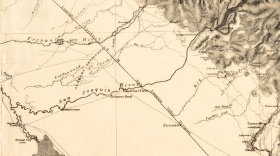Over a century ago, the development irrigation canals made the Valley's farms and cities possible. But what made those canals possible? Today on KVPR's Central Valley Roots - the story of a key technological breakthrough that had worldwide impact - the Fresno Scraper.
James Porteous came to Fresno in 1877 and opened up a wagon shop, Fresno Agricultural Works. He eventually turned his focus to manufacturing farm implements. Through a series of innovations of his own, and from other inventors in Selma, Porteous set out to transform the old horse drawn buck scraper. His new design made it a more useful and efficient tool for digging the canals and ditches that made the valley thrive.
Like the old buck scraper, the Fresno Scraper used a blade to level the earth. Unlike the buck scraper, the Fresno featured a hinged bucket and skids that allowed the user to scrape the earth, then slide a full load of dirt to a new location and finally to dump the soil.
Porteous would eventually buy the patents owned by Selma’s William Deidrick, Frank Dusy and Abijah McCall and by 1883, the Fresno Scraper reached its final design. Eventually tractors would replace horses, only increasing the scraper’s efficiency. It would revolutionize earthmoving beyond the Central Valley, and was used to build projects ranging from Highway 99 to the Panama Canal. Porteous's company was later renamed Fresno Ag Hardware and is the oldest continually operating business in Fresno.
According to The American Society of Mechanical Engineers, the Fresno Scraper is the foundation of all modern bulldozers and giant articulated earthmovers.





